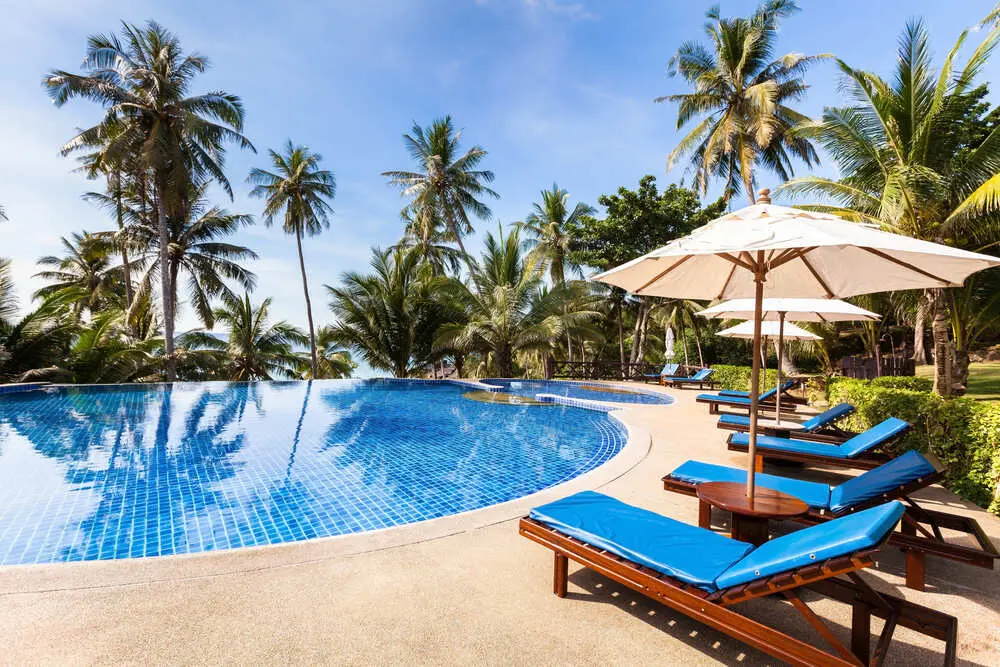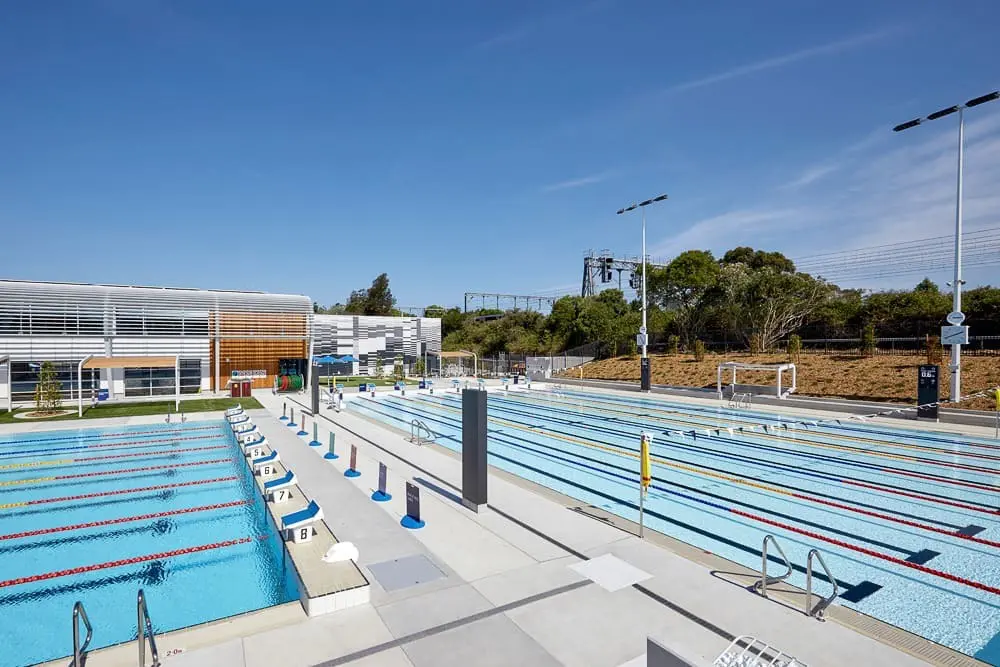An outdoor swimming pool adds value to any property. Making good decisions during its construction will guarantee it remains cost-efficient and easy to manage and maintain.
When it comes to transforming an aquatic facility into a profitable business, building an outdoor swimming pool can be an excellent choice. Not only does it provide a refreshing escape during hot summer days, but it also adds value to your business and enhances outdoor areas for the benefit of potential users.
Setting up an outdoor swimming pool requires careful planning: various factors need to be considered in order to guarantee the installation is cost-efficient in the mid and long term. This is why we’re going to guide you through the essential aspects you should take into account when building an outdoor swimming pool.
Dive deeper with the eBook
A step-by-step process to building an outdoor swimming pool
The location
Choosing the right location for the pool is the first and crucial step. Factors such as sunlight exposure, accessibility, and views provide help in guiding this decision, so that areas that are exposed to sunlight throughout the day are preferred.
Additionally, before starting the construction process, it’s essential to ensure the ground is stable and obtain the necessary permits from local authorities, which may vary according to different countries and its regulations.
Design and layout
These refer to factors such as pool shape, size, depth, and any additional features like waterfalls or fountains. This is also the moment to consider the various pool types to choose from, which include:
- A leisure pool for hotel, resort or camping users and public facilities;
- A wellness hydrotherapy pool or vitality pool to relax in spas and wellness centers;
- A water park pool with slides;
- A sports pool for athletes and sport club users to train and compete, such as an Olympic pool, a semi-Olympic pool, a lap pool, a diving pool, etc.
At the same time, all possibilities in construction systems and materials must be considered, including options such as concrete, EPS, stainless steel or modular panel pools with a vinyl liner.
Design and layout choices of the outdoor swimming pool should align with the business’ goals, preferences and complement its overall aesthetics and brand image. The case of competition pools for official events is different, as they are obliged to comply with the dimensions and requirements set by the World Aquatics federation.
Either way, hiring a professional pool designer will help bring your vision to life and ensure a well-designed pool.
The construction process
Once the design stage is completed, it’s time for the construction process to begin. First comes the site preparation and excavation, followed by the installation of the pool basin. Nowadays, modular panel pools represent an easier and quicker system to build the pool basin in a reliable and accurate way.
These panels are designed and manufactured according to the pool basin and then assembled using screws and chemical anchors. Then comes the installation of filtration ducts, as well as the liner waterproofing system (made of reinforced PVC). This approach represents a step forward from concrete pools, where the pool basin is formed by pouring concrete (formwork) and subsequent tiling with gresite.
In any case, all construction processes will require proper hydraulic and mechanical systems. The correct installation of filtration systems, pumps, and heaters is essential to maintain an adequate water quality and temperature.
There is also the option of installing an above ground pool with a fully prefabricated Plug & Play solution. Made of synthetic fiber and polyester and quick to install, they are usually small pools that can be ideally integrated into the terraces of hotel rooms, campings and resorts.
Again, hiring experienced professionals who can handle all tasks efficiently and ensure proper structural integrity is essential to guarantee a seamless construction process.
Pool safety measures
Safety should be a top priority when building an outdoor swimming pool. There are many elements that can contribute to an enhanced security, including features such as pool covers, lifeguard elements, anti-slip surfaces, non-sharpened edge materials, lights, ladders, handrails, etc. Besides, compliance with local safety regulations is imperative for creating a secure environment.

Landscaping and accessories
When it comes to building an outdoor swimming pool, working to devise an outstanding user experience is key. In fact, an outdoor swimming pool must be designed with the users’ behavioral dynamics in mind. In other words, all areas beyond the pool itself must also be carefully planned from the very first steps in order to conceive a harmonious space that boosts the facility’s economic performance.
There are many ways in which operators can enhance an outdoor swimming pool’s ambiance. Incorporating landscaping elements and creating an inviting atmosphere is often a winning strategy. In the case of hospitality, wellness centers or water parks, trees and flowers can be a source of natural beauty while providing privacy and shade. Moreover, the incorporation of wood tends to integrate seamlessly in green environments, while other material options such as concrete and stainless steel provide a perfect match with modern and minimalist styles.
Aside from aesthetics and design, investing in spaces that combine recreational water activities and economic elements helps boost any business’ turnover. Depending on the choice of pool type, these are some of the features that can be considered:
- Lounge areas
- Outdoor LED lighting for night users
- Restaurants and cocktail bars
- Water features such as slides, cascades, water jets, etc.
Thematization is another aspect to take into account in an outdoor swimming pool, particularly for those considered as recreational pools. Whether mimicking nature, a particular culture or historic time or recreating fantasy worlds, thematic swimming pools provide cohesive and immersive experiences for users that are hard to forget.
In today’s competitive environment, in which differentiation is vital, a themed outdoor swimming pool offers an outstanding appeal that captures users and invites them to spend more time in the pool and its surrounding services. This, in turn, translates into a number of economic benefits.
Space optimization solutions (such as movable bulkheads and movable floors) must also be considered for their ability to transform a pool into a multifunctional space in which to host various activities with different pool needs, especially in the case of pools intended to host sport and leisure activities.
Once again, the case of sport pools is different. In this case, competition and training accessories must be considered, which include lane ropes, podiums, starting platforms, turning panels, indicators for backstroke turns, and so on.

Pool maintenance and operational efficiency: the secret to a successful outdoor swimming pool
Regardless of location, business sector or target audience, an outdoor swimming pool facility needs to ensure its water presents the most optimal quality conditions. This is why water treatment systems and regular cleaning represent key aspects to a well-functioning outdoor swimming pool.
What is more, water treatment technologies go beyond achieving a clean swimming pool: they also help extend the life of all pool components and accessories, and can be behind significant energy savings for the operators. The following are some of the key technologies to be taken into account:
- Water recirculation systems with variable-speed pumps work according to the pool’s maintenance needs, thus achieving great efficiency. They can also be combined with reutilization systems, which can help reusing the water for sanitary purposes or filter backwashing.
- Disinfection and filtration systems are in charge of removing impurities and potential harmful contaminants from the water. As such, they are key to keeping the water within safe operating parameters. These include sand filters or regenerative filters (which perform a mechanical cleaning) and chemical disinfection operations (that can be manual, but are facilitated by systems such as saline chlorination, Neolysis, and Freepool2), which involve adding products to the pool, such as chlorine tablets, flocculation products, etc.
Regarding operational efficiency, water temperature can also play an important role, particularly in the case of an outdoor swimming pool. Today, the incorporation of efficient heat pumps is allowing operators to reach high efficiencies and savings thanks to innovative models. For instance, some heat pump models heat water by employing the thermal heat available in the air.
Maintenance considerations should also be taken into account. Physical and functional elements of a pool must be cleaned as well, including the pool basin itself and its surrounding elements (such as handrails, ladders, water jets, lights). Again, while this can be performed manually, the emergence of automatic solutions is facilitating maintenance and cleaning in outdoor swimming pools today.
Automatic robot cleaners are an excellent option for daily cleaning, sweeping the swimming pool basin without any additional effort. However, small areas beyond their reach and other pool surrounding elements must be cleaned manually with specific disinfection products and tools, while always considering the materials they are made from.
Finally, the pool cover stands out as a key element in both recreational and sport outdoor swimming pools¡. This accessory is great for keeping water clean from external debris, as well as reducing water by evaporation and losses and keeping constant temperatures. In fact, a thermal pool cover can even absorb the sun’s rays during the day, pushing energy efficiency further. All covers are also excellent safety features, since they prevent accidental falls, aside from helping pool operators save energy and cleaning costs as well as enhancing its safety when the pool is not being used.
How to ensure a quality outdoor swimming pool
As seen above, the construction of a successful outdoor swimming pool involves a myriad of aspects that must be taken into account. This results in an undeniable conclusion: a successful outdoor swimming pool can only be realized through accessing expert advice and know-how.
While an outdoor swimming pool remains an attractive selling point for any business, it’s important that its design and construction take into account the needs for ensuring it remains a cost-effective investment.
From initial design and aesthetics to the choice and installation of technical equipment and compliance with regulations, only professionals in swimming pool engineering and construction can guarantee the best end results.
